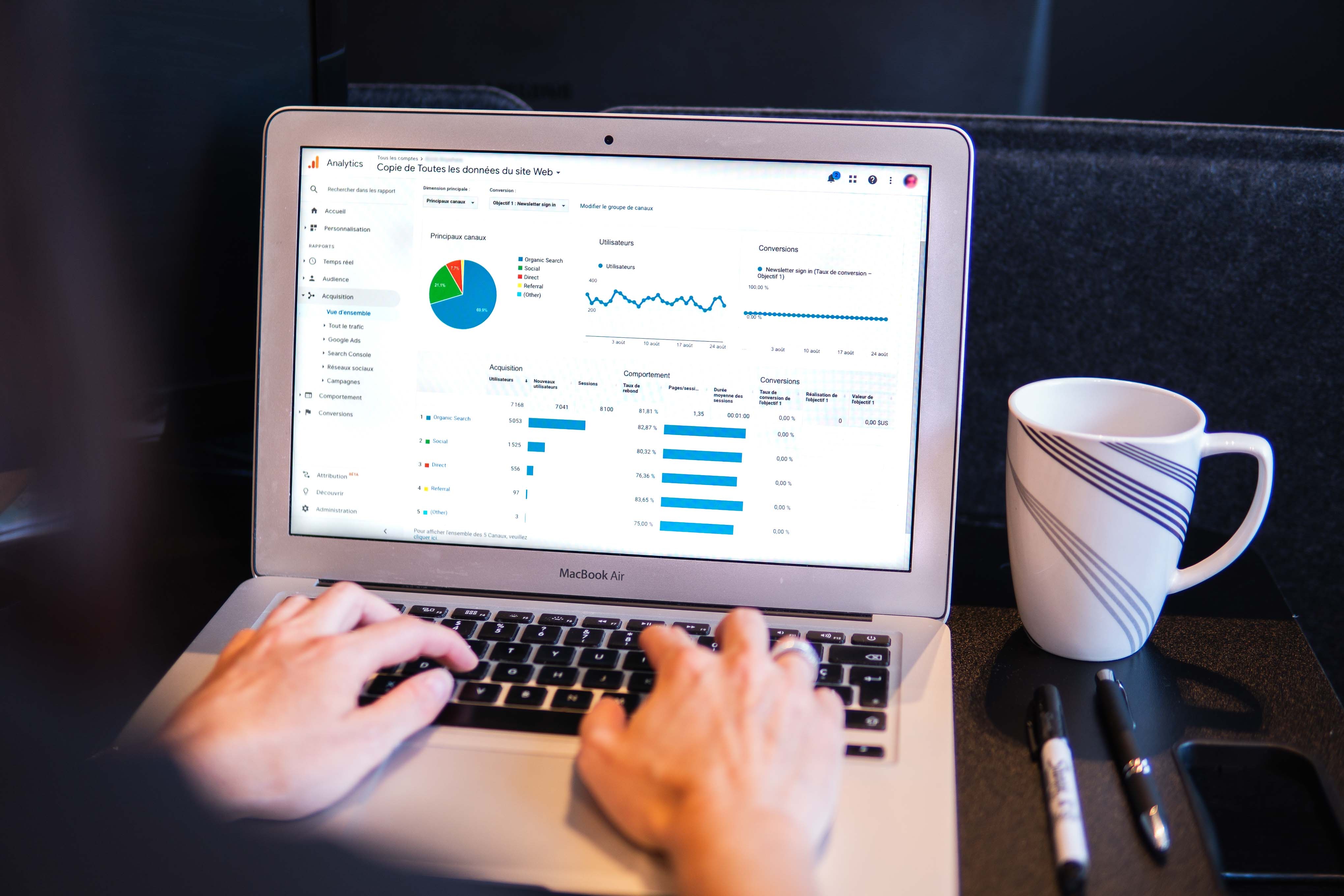
How To Measure, Analyze And Optimize Your Website Traffic With Google Analytics
Learn how to measure, analyze and optimize your website traffic. With Google Analytics. And get to know your most valuable website visitor to make better decisions.
Google Analytics is one of the most important free tools. For measuring how well your website is doing. It's how you can track and measure how many people are visiting your site. How long they stay, where they're from, what they look at, and much more.
In this guide, we will go through some of the most important features of Google Analytics. Which can help you measure, analyze and optimize your website traffic.
The Three Key Players in Website Analytics
Today's web analytics is based on the concept of the web user. It's an old idea, but new technology has made it possible for the web user to be tracked and for data to be collected. Google's goal when it started was to build a tool for search engine optimization.
This tool allowed marketers to see what was happening on their sites. And to track conversions. Now, with the advent of online marketing tools. Like those from HubSpot and Google Analytics. We can track website visitors across all their digital channels.
What is Google Analytics?
Google Analytics is a free website analytics service provided by Google. It allows users to track various types of data. Including the number of people visiting their websites. Where they came from, what pages they viewed.
How long they spent on each page, and much more. The information can be used to identify visitor trends, check website traffic. And analyze user activity over time.
For example, a marketer could use the site’s tracking information. To determine if their product pages were bringing in more visitors. Then other parts of their site.
Google Analytics Installation
There are several ways you can use Google Analytics. You can have a dedicated tracking code that loads on all your pages. Which would be best if you wanted to see data from every page on your site.
Or you can have a single tracking code that loads on only one page on your site. Which would be better for sites with many different pages.
Step-By-Step Guide to Getting Started
This guide will help you get started with Google Analytics. The free web analytic tool. Allows you to measure traffic, conversions, and other metrics. This guide covers setting up your Google Analytics account. And collecting the basic data you need. To know to start making smart marketing decisions.
A Few More Things to Know About Google Analytics
Google Analytics is a free web analytics tool used by almost all websites today. In fact, it's even available on a mobile device! You can use Google Analytics to check and measure traffic.
Including page views, unique visitors, search terms, referring sites. Top content and keywords, social media sharing, bounce rate, time spent on site, etc. And if you don't want to go through the effort of setting up your own analytics tool. There are some great free alternatives out there. Such as Alexa Web Analytics and Yandex Metrica.
Google Analytics Setup Guide
Google Analytics is an extremely useful tool for website owners. That helps them check their website's performance. Find out how visitors are navigating their site, and improve their marketing strategy. Google Analytics setup guide makes this very easy to set up on your website.
How to Track Website Performance
Website performance is the way in which a website is measured. And determined to be successful or unsuccessful. Whether you're running a small business or operating a large site.
You need to keep track of all your important numbers to determine how well your site is performing. And what areas of improvement you can make to get the most out of it. This can be as simple as creating a spreadsheet to store your information. And then referring back to it as you measure your progress.
How to Setup Multiple Pages on One Website
Many online marketers set up more than one page on their website. This may seem counterintuitive, but there’s a good reason for this. As we’ve learned, people tend to spend longer on pages they think are well-designed.
Which makes creating many pages a great way to get people to stay on your site longer and read your content.
Google Analytics Implementation
Google Analytics is one of the most widely used tools on the Internet. For measuring website traffic. By tracking visitor data through a variety of means.
Such as how long people stay on your site, what pages they visit. And whether they buy from you or not. You can use the information gathered by Analytics. To improve your site and increase revenue.
Step-by-Step Guide to Setting Up Analytics
This is one of the most basic, yet often overlooked, steps when setting up your analytics. Analytics should be set up in a way that is consistent across platforms. So your data can be used effectively.
This means that if you're going to use Google Analytics, then use it everywhere. Make sure your data is labelled properly (ex. for eCommerce: product, location, quantity, etc. ), and you need to have an account set up for each platform.
How to Track Landing Pages
In the last year. It's become pretty common for marketers. To track their landing pages in Google Analytics. With a combination of internal links, direct traffic, and conversions. We can figure out which pages are most effective and how to make them even better.
I'm a big believer that tracking landing pages in GA is important. But it's not a replacement for user testing. In fact, it can help you identify pages that don't need to be there or that could be improved.
Tracking Your Traffic Sources
A good way to figure out which traffic sources are bringing you the most business. Is to look at where people are clicking on your site. If you’re looking at a web analytics tool like Google Analytics. There will be a section in there called “traffic sources".
Click on that and then click on “traffic sources”. And you’ll get a list of the pages on your site that are being accessed by visitors. You can see what percentage of the traffic is coming from which page. And whether you need to do anything to improve the conversion rate from that source.
A Few More Advanced Analytics Techniques
Let's add a couple more advanced analytics techniques to our arsenal:
Also to the basic analytics of how visitors arrive.
Where they come from, and what they do when they're there.
What pages are getting the most traffic?
Is your site doing well on social media sites?
How about video?
And, if you are working with a web designer or developer. They might be able to use a tool like WebPage Test or GTMetrix. To see how well your website performs under different conditions.
Use Custom Variables To Improve Analytics Reporting
This is an analytics trick that I’ve learned about from the team at Google Analytics. And used many times since. It’s a good idea to start using custom variables instead of a single category or dimension. By doing this, you can group more detailed information about a single event.
Or set of events, and then get a much richer view of that data. For example, if you are trying to see if a certain link or banner ad was clicked on or not. You can assign the click as a custom variable, which will allow you to see if it was successful.
You can also use it for user demographics. (if you’re trying to understand what age groups your users fall into). Or for a particular set of products or events. (if you’re trying to see which events were the most effective for driving traffic).
Using Google Analytics To Find Your Site's Most Important Page
This is one of the most important steps you can take to improve your search engine ranking. You want your users to visit your site's homepage and then go from there. The best way to determine which pages on your site get the most traffic.
Is through a tool called Google Analytics. When Google Analytics is properly installed and used. It can give you a good idea of which pages on your site are driving the most traffic to your site.
This information is valuable because you can see where your site needs to be improved. To get more traffic.
Use Funnels To See Where Visitors Drop Off From Your Site
A good way to see where people are clicking from your site. And how you can use this information is through conversion funnels. This gives you a look at what percentage of the traffic. Your send to your site converts into customers and sales.
The higher the percentage of visitors who make a sale or download a particular resource. The more likely you are to be successful. There are several ways to create these funnels, and some of them are better than others.
Use Charts To Compare Data From Multiple Websites
This type of infographic is great for comparing data sets or metrics from two or more sources. They can also help you present a variety of metrics in one place. The best charts are ones that are easy to read and understand. Make sure that your data is organized in a way that is easy to compare and understand.
Use Funnel Analytics To Optimize Your Site
Use a funnel analysis to determine where you’re losing potential customers. A funnels analysis can help you see. Whether there’s a need to improve your sales and marketing efforts. Start by looking at the traffic coming into your website. And then track how people move through the process of interacting with your site. Funnel analysis is a way to see the flow of your website traffic. So that you can find out where you are losing potential leads and customers.
Create Reports Using Data From Multiple Websites
If you’re familiar with data analysis at all. You know that it’s important to use the right data for the right purpose. That’s why Google Analytics is so popular. It allows website owners to see and understand the data.
Being pulled from a site. Whether it’s for reporting, advertising, or just for general knowledge. One of the major benefits of using Google Analytics is that it is free, easy-to-use, and free to add to your website.
Create a Dashboard in Analytics
When you're running a business. It's essential to be able to see what's happening in your business right now. While there are many analytics tools out there. Google Analytics is a powerful tool to start with and is free to use. You can set up a dashboard. That shows the key performance indicators (KPIs) that you're looking for.
Set Goals in Analytics
Don’t just look at your data. Look at what actions you’ve taken based on that data. What did you learn? What action did you take? Did that action achieve the goal? If you can answer these questions, you’re not just looking at analytics. You’re actually learning from your data. And taking actions that will ultimately lead to growth.
Build Custom Funnels in Analytics
Custom funnels are one of the most overlooked opportunities. To increase your traffic and conversions. This is especially true in web analytics.
Where Google Analytics reports don’t offer a simple way to create a custom funnel.
Yet, this lack a report-level custom funnel builder. Means you’re missing out on a massive opportunity. The ability to create custom funnels will increase your conversion rate. And improve your funnel design by allowing you to see what’s working and what’s not.
Create Custom Reports in Analytics
There are a lot of reasons why you might want to create custom reports in Google Analytics. And many of them revolve around data that isn't readily available. You can create customized reports that will give you all the important information.
About how your site's traffic is growing over time. How much money it's generating, and what pages are driving conversions.
Import/Export Google Analytics Data
Google offers export and import tools that allow you to transfer your data from one tool to another. Yet, there are many factors involved in exporting data.
Especially if you're dealing with a large amount of data. The following steps will get you started. Exporting data from your Google Analytics account.
Analyze Mobile Website Traffic
If you don’t already know, you should be tracking your mobile traffic. Because it's an incredibly valuable piece of data. If you're just starting out. You can find this data by using Google Analytics and creating custom reports.
Use the Advanced Segmentation Tool in Google Analytics
The tool is useful for creating audience segments. Based on specific criteria (like product sale history, email address, or web page content). Rather than just by simple demographics.
You can add more options to your segments. Including conversion events, geographic location, time of day, and more. Once you've created a segment, you'll see it on your Audience Overview report.
You can also export these segments. To your other reporting tools, such as AdWords and HubSpot.
How to Use A/B Testing for Google Analytics
A/B testing is an online method that allows you to test the impact. Of different versions of your site on various metrics. The best part of A/B testing is that you can test one version against another.
Keeping one version as the control. This helps you identify the best version of your site. To use by comparing your current results to the ones from the other versions. A/B testing is helpful when you’re looking to get more people to take the desired action on your website.
In conclusion on Google Analytics
When it comes to measuring and optimizing traffic to your site, there are lots of different ways to go about it. Some people are content with a general overview of what’s going on with their traffic. While others want a bit more detail about where their traffic is coming from and how they can improve it. Regardless of which method you choose to use. It’s important to keep track of all the traffic you’re receiving. From various sources, so you can better analyze and optimize your website traffic.
Use this guide to make sure you’re getting the best value for your website traffic.
Meta Title: How To Use Google Analytics To Measure, Analyze And Optimize Your Website Traffic
Meta Description: This article gives you a step-by-step walkthrough on how to use Google Analytics to measure, analyze and optimize your website traffic.

FREE sign up below to get
FREE Website Hosting on our Servers
FREE Membership Site
FREE Auto Responder
FREE Chat Bot for your Website
NO CREDIT CARD REQUIRED EVER
Google Analytics








